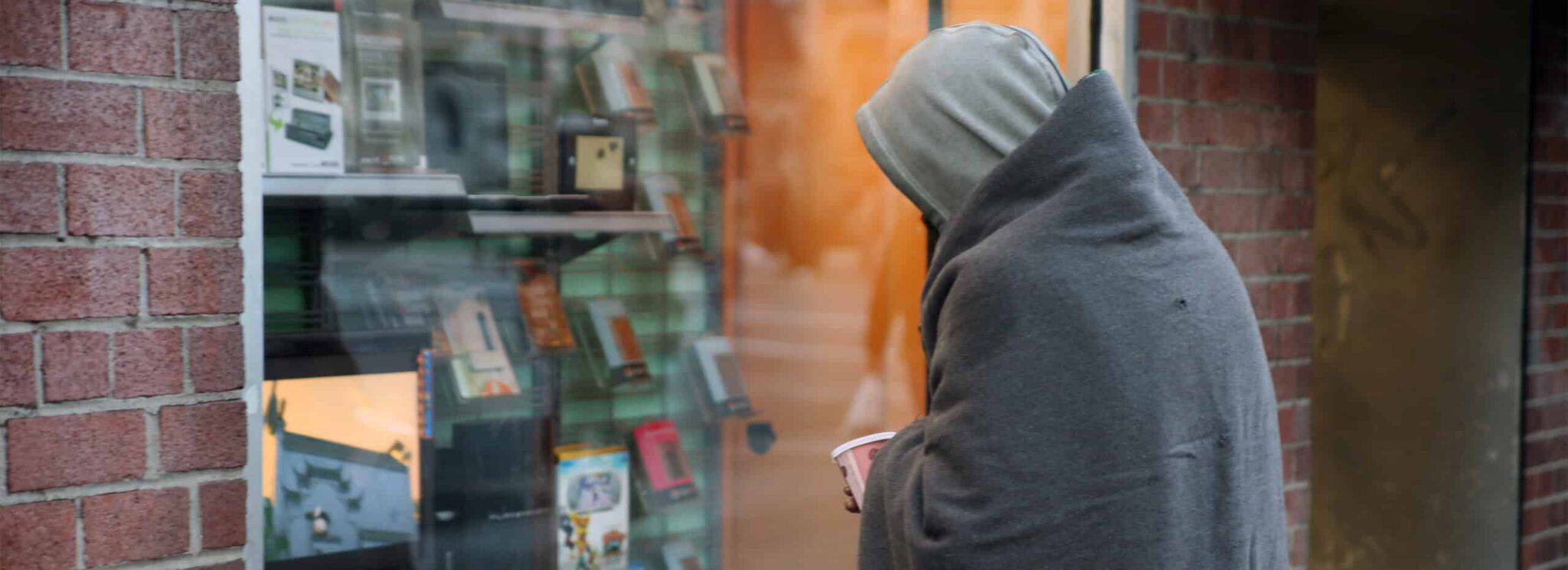Many municipalities have laws against camping on public property. As a result, it drives people to private commercial properties. A vagrant loitering on commercial properties is bad for business. Unwelcome people who hang around your commercial property — whether it’s a shopping center, office building, apartment complex, or construction site — negatively affect your reputation, net operating income, employees, and visitors.
Loitering can be a stepping stone to vandalism. Some are homeless who look for dumpsters and parking garages on commercial properties. They use the apartment pool to bathe. They do whatever it takes to sleep, bathe, eat, and survive.
How Loitering Hurts Commercial Properties
Simply put, loitering is when a person sits around on a commercial property without permission or plans to buy anything from the business.
Loitering causes security concerns and deters customers, employees, and visitors from entering the property or building. The fact is when people see someone laying around on a property, they may not feel safe or comfortable entering. They don’t know whether the person is dangerous.
This, in turn, costs money for your business. The loiterers can drive visitors, tenants, and vendors away from your business. Employees may stop to chat with the loiterers or spend time with them. When they do this, the employees are not doing revenue-generating activities.
If you manage a retail center, an office building with multiple tenants, or an apartment, then current and prospective tenants will look elsewhere. They may not want to rent from a place where their customers or families feel unsafe. This affects your property’s image and brand.
The Effects of Homelessness on Loitering
Every person who is without a home has a story. Unfortunately, being homeless means constantly seeking places to do daily activities. It’s basic survival.
Cities and states have their own anti-loitering laws that make it a crime to do life-sustaining activities in public places. “Forced into Breaking the Law” reports that New Britain, Connecticut’s municipal code does not allow anyone to sleep on a park bench.
Between 2012 and 2015, the Dallas Police have issued more than 11,000 sleeping-in-public citations per Dallas Observer. At the time, the fine was $146. Homeless people caught loitering cannot afford that.
The Los Angeles Times reports police arrested 14,000 homeless people in 2016, a 31 percent increase from 2011. The fines cost less than $100, but that climbs to $200 to $300 when you add court fees. Moreover, the homeless people receiving tickets don’t have an address and fail to show up in court. That causes the fines to balloon.
The fine for sleeping on the sidewalk in L.A. is $35, which climbs to more than $200 after adding fees. These include conviction fees, court security, emergency medical, DNA lab, criminal surcharges, county penalty fund, state penalty fund, and so on. These folks are homeless. How are they supposed to pay a fine especially when it keeps climbing?
So, what do they do? When law enforcement tells a homeless person to leave, the person moves on to the next spot. That spot could be your business.
National Law Center on Homelessness and Poverty’s No Safe Place reveals the following statistics:
- One-third of cities ban camping in public
- More than half of cities ban camping in certain public places
- One-third of cities forbid loitering, loafing, and vagrancy in public
- Two-thirds of cities outlaw loitering, loafing, and vagrancy in certain public places
Rather than risk getting caught in public places where police patrol, the homeless will seek a place to camp that’s not public.
Of course, everyone would like to see a solution to homelessness. It’s a big problem and a hard cycle to break. In the meantime, businesses need to keep functioning without those who are disrupting operations.
The first thing to do is to treat homeless visitors as humanely as possible. No business wants to end up in the news for mistreating someone regardless of breaking the law.
How to Humanely Remove a Homeless Person from Your Property
What are the most humane ways to deter loitering due to homelessness? Start by posting a “No trespassing” or “No loitering sign.
If the person continues to loiter, ask the person to please leave, explaining that you are enforcing the “no trespassing” policy. However, the employee with this responsibility may feel uneasy about doing this. Also, no one may be on site when a loitering situation happens.
You don’t want an employee or a customer to run into this situation. It may not be safe for them to ask someone to leave the premises. A better option is to ask the police to step in because they have the training for handling these situations.
Law enforcement focuses on public spaces like city parks. They do not proactively monitor commercial properties. That is why retail centers, apartments, and other commercial properties implement a proactive security solution like live video monitoring.
With remote video monitoring, a trained operator watches your property using cameras strategically placed around your property. Upon spotting a problem, the operator can either try the audio deterrent to alert the person loitering or call the police if the situation warrants it.
The City of Philadelphia believes security cameras are the best option for increasing safety on commercial properties. As a result, the city has a Business Security Camera Program to encourage businesses to install video cameras.
According to the Philadelphia Department of Commerce, the owner of a pizzeria reports that no one loiters on his corner anymore since he joined the program. His property will add an ice cream shop and provide more options for the neighborhood.
An owner of another Philadelphia restaurant had previously installed security cameras on his own. The system turned out to be useless because the system and footage were not of good quality. That’s why it’s important to work with an experienced security firm when implementing a video security system. You want to do it right the first time and not waste a dime.
How Live Video Monitoring Can Safely Remove Loiterers
Here’s an actual example of a trained operator watching video surveillance cameras at a Houston shopping center. The operator spotted someone sleeping on the property who should not be there. He called the police to report it.
The police tried to arrest the trespasser who did not cooperate. After time passes, the police call the EMT to do an evaluation. After verifying the person did not have health issues, the police walked the suspect to the police car.
Video monitoring leads to the police safely removing a vagrant from a commercial property. If the vagrant had gotten hurt on the property, the business would be held liable and possibly sued. Since the business implemented live video surveillance, it had proof of loitering.
The operator contacted the police and fire department who escorted the person off the commercial property. An hour later, the person returned and the trained security operator contacted the police again. They arrested the repeat offender without incident.
Without video monitoring, the business would not have known about the loiterer. Instead, it could have risked employees’ safety when they arrived on the property during working hours. They would either not enter the building or put themselves and the loiterer in danger in trying to handle the situation without training.
In another scenario, a loiterer walked on a shopping center’s property after-hours. He put his coat down on the wet grass and lay down. The shopping center’s video surveillance monitor spotted the trespasser and activated the speaker warning. That did not deter the loiterer. The operator called the police department. The responding police officer arrived on the scene and arrested the individual.
Implementing the Right Remote Video Surveillance System
Proactive remote video surveillance uses a combination of video analytics and human intelligence to make sure your property always has sharp eyes on it. ECAM’s customized security camera system has led to the capture of many loiterers on commercial properties.
Frequently Asked Questions About Commercial Loitering
Loitering on commercial properties can deter customers, employees, and visitors, negatively impacting the reputation, net operating income, and overall safety of the property. It can also be a precursor to vandalism and other security issues.
Loitering can lead to decreased customer traffic, lower employee productivity, and a tarnished property image. Current and prospective tenants may look elsewhere if they feel their safety is compromised, affecting rental income and property value.
Businesses can post “No trespassing” or “No loitering” signs and ask loiterers to leave. For safety reasons, it is often better to involve law enforcement or use a proactive security solution like live video monitoring.
Live video monitoring involves trained operators watching strategically placed cameras on the property. When loitering is detected, operators can use audio deterrents or contact police if necessary, ensuring a swift and safe resolution.
A remote video surveillance system combines video analytics and human intelligence to provide continuous monitoring. It can deter loitering, prevent potential crimes, and enhance the safety and security of commercial properties.
It’s important to work with an experienced security firm to ensure the system is effective and reliable. High-quality footage and strategic placement of cameras are crucial for successful monitoring and intervention.
Programs like the City of Philadelphia’s Business Security Camera Program encourage businesses to install security cameras by providing support and incentives, enhancing overall community safety.

